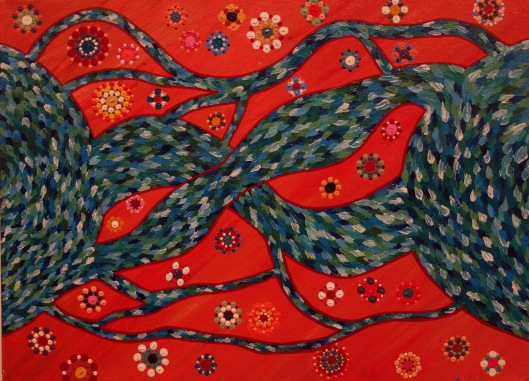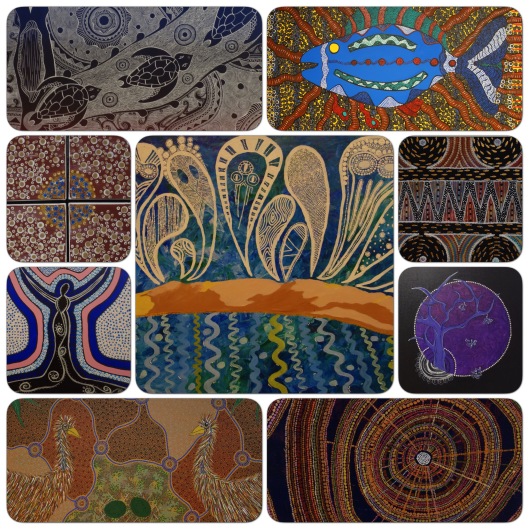NAIDOC Week celebrations are held across Australia each July to acknowledge the history, culture and achievements of Aboriginal and Torres Strait Islander peoples. This year the theme is Our languages matter. In the late 18th century, when the British invaded, there were 250 distinct Indigenous language groups, most with several dialects. Today only about 120 of those languages are still spoken: there are many attempts to reclaim languages that are almost lost, often word by meagre word. Many members of the Stolen Generation remember being beaten for speaking language, as a frontline attempt at brutal assimilation.
Stanthorpe Regional Art Gallery in partnership with the Granite Belt Aboriginal and Torres Strait Islander Corporation marks the week with an exhibition of Aboriginal art by local and visiting Aboriginal and Torres Strait Islander artists. It “connects past and present, people and land, spirituality and reality,” representing one of the oldest ongoing traditions of art in the world. It offers me many pleasures: design, colour and familiarities.
The first collage is a mix of items behind glass: Aboriginal designs on wood, cap, ceramics, shells, and baby jumpsuits. The two brown and black wooden bowls are by Timeika Reena Slockee; the shells by Aurora De Vries; and to my shame I didn’t record Jumpsuit details.
A few artists are so distinctive that I recognise them instantly: Krishna Heffernan’s “Gum flowers”, “Campfire”, “Creek bubbles” and “Brisbane River”, all bright with acrylic, paper and thread on canvas …
… Corina Graham’s mixed media with gold leaf …
… Rod McIntosh’s elegant stylised animals …
… and Timeika Rena Slockee’s “Sandhills”, “Wild flowers at the waterhole”, “Mothers of nature” and the painting that expresses the theme of NAIDOC week, “Reconnecting language.”
There are too many painting that please me to feature each one separately, so here’s a collage with attributions clockwise from the top left: Chenaya Bancroft-Davis’ linoprint “Sacred site”: Maris de Vries’ “Mudfish” (acrylic on canvas): Bronwyn Smith’s “Fish trap” (acrylic on canvas): Chenaya Bancroft-Davis’ “Jacaranda season” (acrylic on canvas): another Bronwyn Smith “Fish trap” (acrylic on canvas): Marica Staples’ “Emus” (acrylic on canvas): Tully de Vries’ “Gali lady” (acrylic on canvas): Amanda Watts-Nyoor’s “Kungarakan mum” (acrylic on canvas): and in the centre Amarina Nhaynes’ “Moorgumpin Nguru Wandehn – Moreton Bay spirits” (acrylic on canvas).
I can’t resist a few closeups: Charmaine Davis’ “The rocks” (acrylic on canvas) because of its connection with boulder country …
… and River Brando Binge’s “Miri Mari – star people” because of its drama and the way it mixes traditional Aboriginal dots, handprints and figure with modern owl and starbursts in a circle.
I end my personalised exhibition with the unexpectedness of a shower curtain, Melanie Forbes’ black and white “Tree of life” (digital print on PEVA) …
… and, for my daughter whose avatar is the quoll, Kim Charles’ “Spotted quoll” (acrylic on canvas).

















The jump suit was by Tully De Vries
LikeLike
Thanks for filling in my gaps. I try very hard to attribute, but I don’t always succeed.
LikeLike
There are too many that please me as well! The very feminine trees with low hills in the background and constellations of circles behind and most of all, the bright orange and red spiralled rocks with blue bubbly water below is fabulous.
LikeLike
A lovely tour of beautiful art work. Thanks, Meg.
LikeLike
Meg, What a feast for the eyes and for the soul. Wonderful images, every one of them. Thanks so much. Three cheers for your cameras, and more cheers for you! xx
Prue
LikeLike
Love the Brisbane River and the Rocks. I wanted to buy some Australian art, but it is soooo expensive. Your photos are delightful and I thoroughly enjoyed this very colourful post.
LikeLike
Such a wonderfully rich and colourful diversity of indigenous artworks to appreciate. Locally in Tilba there were Naidoc celebrations and opportunities to just have a chat with some of the artists, particularly at a gathering at Open Sanctuary.
LikeLike
Stanthorpe Gallery exhibitions are always worth seeing: a nice manageable number of artworks, uncrowded, spacious. Open Sanctuary hosts so much that is good – including your birthday!
LikeLike
What wonderful, vibrant, expressive art, Meg
LikeLike
There was more, but my photos didn’t do justice.
LikeLiked by 1 person
That I don’t entirely believe….
LikeLike
Oh, believe! I’ll give the statistics of my discards one day.
LikeLiked by 1 person
Don’t worry, I always have plenty myself!
LikeLike